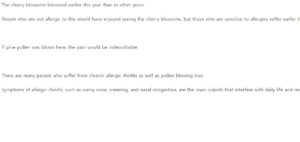The cherry blossoms bloomed earlier this year than in other years.
People who are not allergic to this would have enjoyed seeing the cherry blossoms, but those who are sensitive to allergies suffer earlier than usual.
If pine pollen was blown here, the pain would be indescribable.
There are many people who suffer from chronic allergic rhinitis as well as pollen blowing iron.
Symptoms of allergic rhinitis, such as runny nose, sneezing, and nasal congestion, are the main culprits that interfere with daily life and reduce concentration.

Not only can the quality of life be lowered, but there may also be restrictions on social life.
Allergic rhinitis, which causes various problems, has been searched for answers on how to diagnose and treat it.
Treatment of allergic rhinitis begins with diagnosis
Allergic disease treatment begins with an allergy diagnostic test to find the cause.
First of all, a blood test called ‘MAST test’ is performed. If the test is positive, allergic rhinitis can be diagnosed.
Then, let’s take a closer look at how to interpret, diagnose, and proceed with treatment.
There are many different substances that cause allergies.
When these allergens enter the body, a sensitization reaction occurs. Sensitization can be understood as the first step in an allergic reaction.
The MAST test is a test to determine whether or not this sensitization reaction exists.
When our body reacts to a specific allergy-causing substance from the outside, it makes a specific antibody (IgE), and it can be known by the MAST test.
For example, if a patient has an allergic reaction to a particular pollen, the MAST test results will be positive for the pollen.
In addition, if the cause of the allergy is house dust mite, a positive result is obtained for house dust mite.
The specific antibody (IgE) level appears in steps of +1 to +6, and the higher the level, the more sensitization reactions have occurred.
A high sensitization reaction does not mean that the allergic symptoms are severe.
However, it can be determined that the substance is highly likely to have acted as a cause of allergy.
This means that the cause of allergy can be identified.
Not all patients with rhinitis have allergic rhinitis.
This MAST test can determine whether or not the cause of rhinitis is an allergy, so it can be said to be an important diagnostic test.
This is because it is possible to treat the root cause only when you know the exact cause.
Among patients with common rhinitis, about 76% are allergic rhinitis.
About 24% are non-allergic diseases such as infectious, occupational, drug-induced, hormonal, and vasomotor diseases.
If the MAST test determines that it is not an allergic disease, another diagnosis and examination should be performed, and treatment should be sought by a medical professional specializing in the field.
For this reason, it is important to accurately diagnose allergic rhinitis in the first place.
Fundamental treatment of allergic rhinitis
Allergic diseases often start as Venus and progress chronically.
If treatment of Venus diseases such as hay fever is missed or delayed, it is likely to lead to relapse and progression of inflammation, which will become a chronic disease.
Therefore, it is necessary to carry out management treatment to avoid the cause of allergy by making an early and accurate diagnosis.
In other words, it means that not only the treatment of acute symptoms, but also the long-term management treatment must be continuously performed to fundamentally overcome allergies.
Once allergic symptoms such as rhinitis develop, it is necessary to manage them intensively with medication at an early stage.
As drug treatment, antihistamines, intranasal steroids, counterleukotrienes, cromolyn, nasal decongestants, and intranasal anticholinergics are used, and the main purpose is to relieve symptoms.
There is also immunotherapy among allergy treatments.
After examining the allergen, a substance that causes allergy, it is a treatment that starts with a small amount and gradually increases the amount of the allergen.
There is also a way to fundamentally treat the allergy by slowing down the hypersensitivity reaction while increasing the frequency of exposure to the allergen.
Immunotherapy includes subcutaneous immunotherapy, in which an allergen is injected, and sublingual immunotherapy, in which a pill is easily dissolved under the tongue and slowly dissolved.
For subcutaneous immunotherapy, several allergens can be used.
However, side effects may occur, and children who are afraid of injections or office workers who have difficulty visiting the hospital may feel burdened.
On the other hand, sublingual immunotherapy is a prescription pill that is dissolved under the tongue and taken twice a week, and has the advantage of being able to maintain treatment at home.
Immunotherapy requires continuous treatment for about 3 years and can be treated more fundamentally than drug treatment, so complete treatment can be expected.
In this way, allergic diseases can be sufficiently overcome by accurately diagnosing them early and applying appropriate treatment.